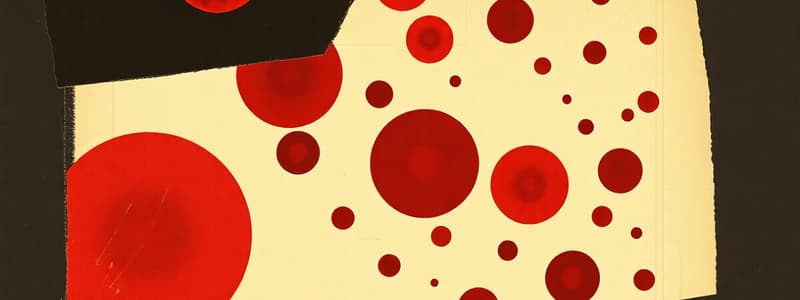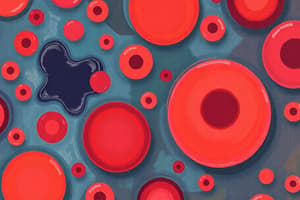Podcast
Questions and Answers
What is the life span of erythrocytes before they are engulfed by macrophages?
What is the life span of erythrocytes before they are engulfed by macrophages?
- 10-15 days
- 15-20 days (correct)
- 20-30 days
- 5-10 days
Which type of leukocyte is characterized by a bilobed nucleus?
Which type of leukocyte is characterized by a bilobed nucleus?
- Basophils
- Eosinophils (correct)
- Lymphocytes
- Neutrophils
What shape are erythrocytes normally classified as?
What shape are erythrocytes normally classified as?
- Hexagonal
- Spherical
- Cylindrical
- Flexible, biconcave discs (correct)
Which blood cells are most abundant in circulation?
Which blood cells are most abundant in circulation?
What is the primary function of lymphocytes?
What is the primary function of lymphocytes?
What percentage of circulating leukocytes do neutrophils constitute?
What percentage of circulating leukocytes do neutrophils constitute?
Which of the following characteristics does a basophil have?
Which of the following characteristics does a basophil have?
What is the average size of an erythrocyte?
What is the average size of an erythrocyte?
Which leukocyte type has a life span of 10-15 days?
Which leukocyte type has a life span of 10-15 days?
What abnormal shape can erythrocytes take?
What abnormal shape can erythrocytes take?
Flashcards
What are red blood cells (RBCs)?
What are red blood cells (RBCs)?
The most abundant cells in the blood, responsible for carrying oxygen. They are flexible, biconcave discs with a diameter of 6-9 μm and a thickness of 2.5 μm at the rim and 0.75 μm in the center.
What is a blood smear?
What is a blood smear?
A blood smear is a laboratory technique used to examine the different types of blood cells under a microscope. It involves spreading a thin layer of blood on a slide and then staining it to differentiate the cells.
What are white blood cells (WBCs)?
What are white blood cells (WBCs)?
White blood cells (WBCs) play a crucial role in the immune system by fighting infections and foreign invaders. They are larger than red blood cells and have a nucleus.
What are neutrophils?
What are neutrophils?
Signup and view all the flashcards
What are eosinophils?
What are eosinophils?
Signup and view all the flashcards
What are basophils?
What are basophils?
Signup and view all the flashcards
What are lymphocytes?
What are lymphocytes?
Signup and view all the flashcards
What are T cells?
What are T cells?
Signup and view all the flashcards
What are B cells?
What are B cells?
Signup and view all the flashcards
What are monocytes?
What are monocytes?
Signup and view all the flashcards
Study Notes
Blood Cell Development
- Blood consists of whole blood, plasma, and formed elements like erythrocytes, leukocytes, and platelets.
- Whole blood composition includes water (92%), proteins, electrolytes, nutrients, respiratory gases, and waste products. Erythrocytes make up 4.2-6.2 million per cubic mm.
- Leukocytes (white blood cells) are 5-10 thousand per cubic mm, categorized as granulocytes (neutrophils, eosinophils, basophils) and agranulocytes (monocytes, lymphocytes).
- Platelets (thrombocytes) range from 150,000 to 400,000 per microliter of blood.
Erythrocytes (Red Blood Cells)
- Most abundant blood cells, flexible biconcave discs.
- 6-9 µm average diameter, 2.5 µm rim thickness, and 0.75 µm center thickness.
- Non-nucleated with a pale center.
- Life span of 120 days; engulfed by macrophages.
- Abnormal shapes include sickle shape and spherocytosis.
- Abnormal sizes include microcytic (diameter <6 µm) and macrocytic (diameter >9 µm).
Leukocytes (White Blood Cells)
- There are different types of leukocytes or white blood cells. Different types of leukocytes are divided into granulocytes and agranulocytes
- Granulocytes:
- Neutrophils (60-70% of circulating leukocytes), size 12-15 µm, segmented nucleus (2–5 lobes), cytoplasm with granules. Life span of 1-4 days.
- Eosinophils (2-4% of circulating leukocytes), size 12-15 µm, bilobed nucleus, cytoplasmic granules, acidophilic. Life span of 8-12 days.
- Basophils (less than 1% of circulating leukocytes), size 12-15 µm, 2 irregular lobes, cytoplasm with granules which stain purple, obscure the shape, contain histamine and heparin. Life span of 10-15 days.
- Agranulocytes:
- Monocytes (3-8% of circulating leukocytes), size 15-20 µm (largest in blood smear), Indented nucleus (C, kidney-shaped), basophilic cytoplasm with azurophilic granules. Life span of 3 days, precursor of macrophages.
- Lymphocytes (20-25% of circulating leukocytes):
- Small lymphocytes (10-12 µm) with a spherical, highly condensed nucleus, thin rim of cytoplasm.
- Medium and Large lymphocytes (7-15 µm diameter) with a more extensive cytoplasm containing few azurophilic granules, slightly indented nucleus.
- Responsible for both antibody-mediated immunity (B lymphocytes) and cell-mediated immunity (T lymphocytes).
Platelets (Thrombocytes)
- Small, non-nucleated cell fragments.
- Diameter: 2-4 µm
- Normal count: 150,000–400,000/µL blood
- Life span: about 10 days
- Stained smears show platelets in clumps, with a light peripheral zone (hyalomere) and a darker central zone (granulomere).
Hemopoiesis (Blood Cell Formation)
- Formation of blood cells from hematopoietic stem cells in bone marrow.
- Myeloid stem cells differentiate into erythrocytes, platelets, granulocytes, and monocytes.
- Lymphoid stem cells form lymphocytes (B cells, T cells, and natural killer cells).
- Various growth factors (e.g., erythropoietin, thrombopoietin, colony-stimulating factors) regulate hemopoiesis.
Blood Smear Preparation
- Blood sample collection involves pricking the finger.
- A drop of blood is placed on a slide and spread across with a second slide, leaving a thin layer, for contrast a stain is used.
- A coverslip is placed on top.
Studying That Suits You
Use AI to generate personalized quizzes and flashcards to suit your learning preferences.




